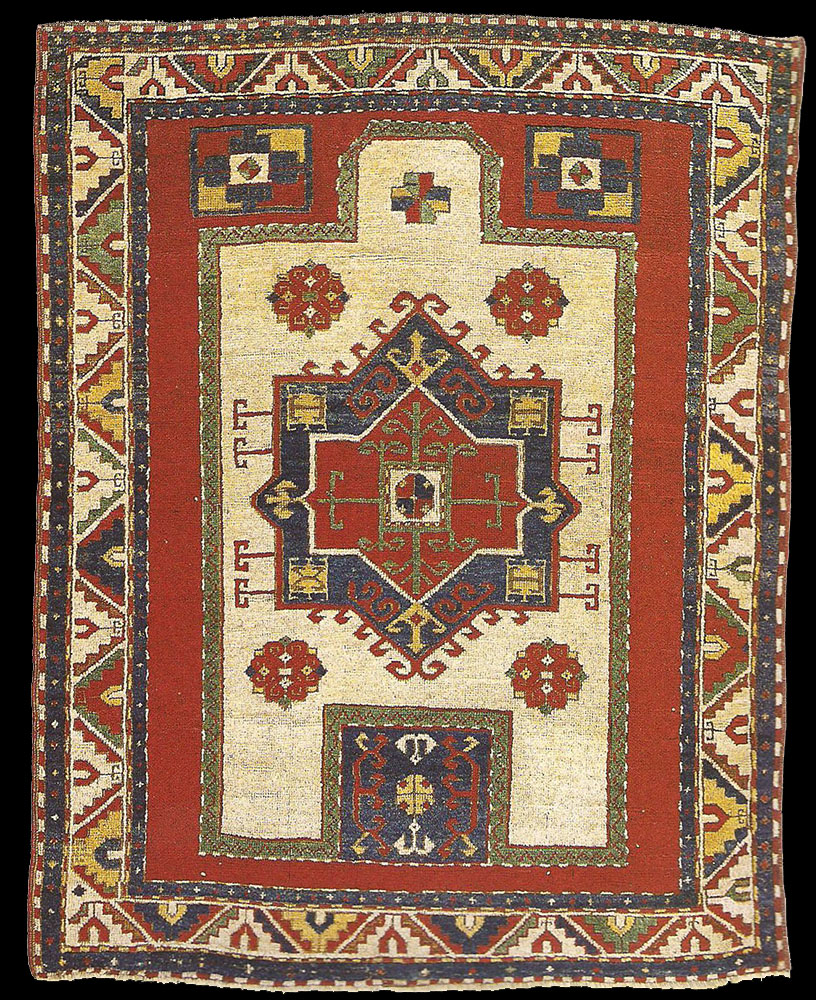|
Ivory-ground Fachralo prayer rugs are extremely rare. This piece was created
in the middle of the nineteenth century, perhaps even earlier, and with its
clear, uncompromising lines is extremely impressive. Only two comparable
pieces from this period are known:
A variant was published in Bausback, Antike Orientteppiche, p.185.
This rug has a rectangular white field with a blue medallion and a finely
drawn prayer arch on a red ground, decorated with stylized tulips and a
white-ground border with crosses. Tschebull, in his article 'The
Development of Four Kazak Designs' (Hali 1/3, pp. 257-61), illustrates a
white-ground prayer rug very similar to this example (fig. 34) with a
white mihrab with a re-entrant motif on a plain red ground. While this
example has the confronting dragon motif in the re-entrant archway, the
Hali example has a latchhooked diamond. The two rugs share many aspects
with the traditional small rugs of Lori-Pambak, which Schurmann described
as 'favouring few colours and large areas of plain colours' (Caucasian
Rugs, p. 8). Herrmann published a secular Fachralo rug with an octafoil
central medallion (ATT4, pl. 41) which, were the medallion replaced with
the typical 'turtle' image (symbolizing longevity), would be virtually
identical in all respects to a well known Lori Pambak (Jacobsen, Oriental
Rugs, p. 446 = Hali 1/3, p.260, fig.32=Hali5/3, p.352=CNY 8 Feb.1992, lot
47). In his text, Herrmann refers to the connection between the two types,
and states that a piece comparable to an early Facralo piece is not known
He identidies two later white ground analogies: Hali 5/2, p.200=SLO 12
Oct. 1982, lot 89; Hali 6/2, p. 192.
The white re-entrant mihrab of undyed wool is dominated by a typical
Fachralo medallion, composed of a smaller red stellar medallion inside the
larger blue eight-pointed star. Small spikes project from the sides, and
latch-hooks emerge from the top and bottom. Pairs of elaborate red
rosettes appear above and below the medallion. The only other decoration
in the mihrab is the polychrome cruciform motif underneath the prayer
niche. The border is the characteristic 'leaf-and-calyx' pattern. The
owner of the rug, Mike Tschebull, is of the opinion that the white wool in
this and similar Fachralos has been bleached, which would explain why it
has not yellowed - even a little - like most white wool.
White-ground Fachralo prayer rugs are attributed by some authorities
to Lori-Pambak. Perhaps it is because of their white fields or a
similarity of colours and their arrangements, or like border designs, or
simply the geographical proximity of the two regions. In recent years a
number of white-ground Kazak carpets with herald-like Lori-Pambak drawings
have been found.
 |

